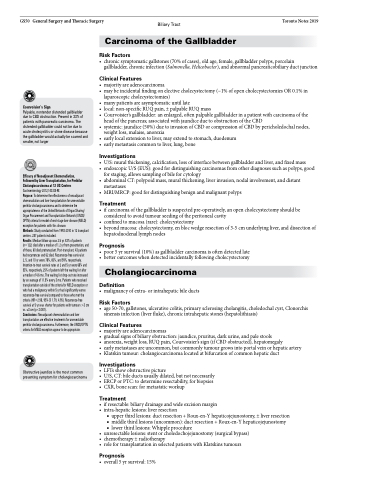Page 452 - TNFlipTest
P. 452
GS50 General Surgery and Thoracic Surgery Biliary Tract Toronto Notes 2019 Carcinoma of the Gallbladder
Courvoisier’s Sign
Palpable, nontender distended gallbladder due to CBD obstruction. Present in 33% of patients with pancreatic carcinoma. The distended gallbladder could not be due to acute cholecystitis or stone disease because the gallbladder would actually be scarred and smaller, not larger
Risk Factors
• chronicsymptomaticgallstones(70%ofcases),oldage,female,gallbladderpolyps,porcelain gallbladder, chronic infection (Salmonella, Helicobacter), and abnormal pancreaticobiliary duct junction
Clinical Features
• majorityareadenocarcinoma
• maybeincidentalfindingonelectivecholecystectomy(~1%ofopencholecystectomiesOR0.1%in
laparoscopic cholecystectomies)
• manypatientsareasymptomaticuntillate
• local:non-specificRUQpain,±palpableRUQmass
• Courvoisier’sgallbladder:anenlarged,oftenpalpablegallbladderinapatientwithcarcinomaofthe
head of the pancreas; associated with jaundice due to obstruction of the CBD
• systemic: jaundice (50%) due to invasion of CBD or compression of CBD by pericholedochal nodes,
weight loss, malaise, anorexia
• earlylocalextensiontoliver,mayextendtostomach,duodenum • earlymetastasiscommontoliver,lung,bone
Investigations
• U/S:muralthickening,calcification,lossofinterfacebetweengallbladderandliver,andfixedmass
• endoscopicU/S(EUS):goodfordistinguishingcarcinomasfromotherdiagnosessuchaspolyps,good
for staging, allows sampling of bile for cytology
• abdominal CT: polypoid mass, mural thickening, liver invasion, nodal involvement, and distant
Treatment
Efficacy of Neoadjuvant Chemoradiation,
Followed by Liver Transplantation, for Perihilar
Cholangiocarcinoma at 12 US Centres
Gastroenterology 2012;143:88-98
Purpose: To determine the effectiveness of neoadjuvant
chemoradiation and liver transplantation for unresectable
perihilar cholangiocarcinoma and to determine the
appropriateness of the United Network of Organ Sharing/
Organ Procurement and Transplantation Network (UNOS/
OPTN) criteria for model of end-stage liver disease (MELD)
exception for patients with this disease.
Methods: Study conducted from 1993-2010 in 12 transplant
centres. 287 patients included.
Results: Median follow-up was 2.5 yr. 43% of patients
(n=122) died after a median of 1.2 yr from presentation, and Prognosis of these, 60 died pretransplant. Post-transplant, 43 patients
had recurrences and 62 died. Recurrence-free survival at
2, 5, and 10 yr were 78%, 65%, and 59%, respectively.
Intention-to-treat survival rates at 2 and 5 yr were 68% and
53%, respectively. 25% of patients left the waiting list after
a median of 4.6 mo. The waiting list drop-out rate increased
by an average of 11.5% every 3 mo. Patients who received
transplantation outside of the criteria for MELD exception or Definition who had a malignancy within 5 yr had significantly worse
recurrence-free survival compared to those who met the
criteria (HR=2.98, 95% CI 1.79, 4.95). Recurrence-free
survival at 5 yr was shorter for patients with tumours >3 cm
vs. ≤3 cm (p<0.001).
Conclusions: Neoadjuvant chemoradiation and liver
transplantation are effective treatments for unresectable
perihilar cholangiocarcinoma. Furthermore, the UNOS/OPTN
criteria for MELD exception appear to be appropriate.
metastases
• MRI/MRCP:goodfordistinguishingbenignandmalignantpolyps
• if carcinoma of the gallbladder is suspected pre-operatively, an open cholecystectomy should be considered to avoid tumour seeding of the peritoneal cavity
• confinedtomucosa(rare):cholecystectomy
• beyondmucosa:cholecystectomy,enblocwedgeresectionof3-5cmunderlyingliver,anddissectionof
hepatoduodenal lymph nodes
Cholangiocarcinoma
• malignancyofextra-orintrahepaticbileducts
Risk Factors
Clinical Features
• majorityareadenocarcinomas
• gradualsignsofbiliaryobstruction:jaundice,pruritus,darkurine,andpalestools
• anorexia,weightloss,RUQpain,Courvoisier’ssign(ifCBDobstructed),hepatomegaly
• earlymetastasesareuncommon,butcommonlytumourgrowsintoportalveinorhepaticartery • Klatskintumour:cholangiocarcinomalocatedatbifurcationofcommonhepaticduct
Investigations
• LFTsshowobstructivepicture
• U/S, CT: bile ducts usually dilated, but not necessarily • ERCPorPTC:todetermineresectability,forbiopsies • CXR,bonescan:formetastaticworkup
Treatment
• ifresectable:biliarydrainageandwideexcisionmargin • intra-hepaticlesions:liverresection
■ upper third lesions: duct resection + Roux-en-Y hepaticojejunostomy, ± liver resection ■ middle third lesions (uncommon): duct resection + Roux-en-Y hepaticojejunostomy
■ lower third lesions: Whipple procedure
• unresectablelesions:stentorcholedochojejunostomy(surgicalbypass) • chemotherapy±radiotherapy
• rolefortransplantationinselectedpatientswithKlatskinstumours
Prognosis
• overall5yrsurvival:15%
• poor5yrsurvival(10%)asgallbladdercarcinomaisoftendetectedlate • betteroutcomeswhendetectedincidentallyfollowingcholecystectomy
• age50-70,gallstones,ulcerativecolitis,primarysclerosingcholangitis,choledochalcyst,Clonorchis sinensis infection (liver fluke), chronic intrahepatic stones (hepatolithiasis)
Obstructive jaundice is the most common presenting symptom for cholangiocarcinoma


